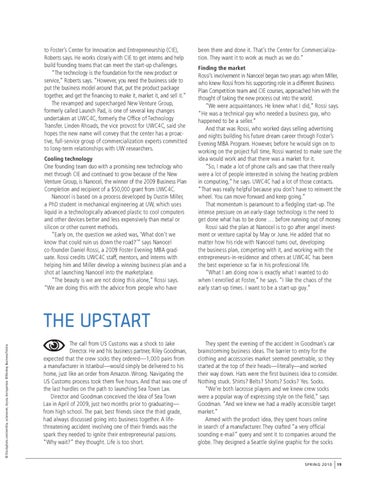to Foster’s Center for Innovation and Entrepreneurship (CIE), Roberts says. He works closely with CIE to get interns and help build founding teams that can meet the start-up challenges. “The technology is the foundation for the new product or service,” Roberts says. “However, you need the business side to put the business model around that, put the product package together, and get the financing to make it, market it, and sell it.” The revamped and supercharged New Venture Group, formerly called Launch Pad, is one of several key changes undertaken at UWC4C, formerly the Office of Technology Transfer. Linden Rhoads, the vice provost for UWC4C, said she hopes the new name will convey that the center has a proactive, full-service group of commercialization experts committed to long-term relationships with UW researchers. Cooling technology
One founding team duo with a promising new technology who met through CIE and continued to grow because of the New Venture Group, is Nanocel, the winner of the 2009 Business Plan Completion and recipient of a $50,000 grant from UWC4C. Nanocel is based on a process developed by Dustin Miller, a PhD student in mechanical engineering at UW, which uses liquid in a technologically advanced plastic to cool computers and other devices better and less expensively than metal or silicon or other current methods. “Early on, the question we asked was, ‘What don’t we know that could ruin us down the road?’” says Nanocel co-founder Daniel Rossi, a 2009 Foster Evening MBA graduate. Rossi credits UWC4C staff, mentors, and interns with helping him and Miller develop a winning business plan and a shot at launching Nanocel into the marketplace. “The beauty is we are not doing this alone,” Rossi says. “We are doing this with the advice from people who have
been there and done it. That’s the Center for Commercialization. They want it to work as much as we do.” Finding the market
Rossi’s involvement in Nanocel began two years ago when Miller, who knew Rossi from his supporting role in a different Business Plan Competition team and CIE courses, approached him with the thought of taking the new process out into the world. “We were acquaintances. He knew what I did,” Rossi says. “He was a technical guy who needed a business guy, who happened to be a seller.” And that was Rossi, who worked days selling advertising and nights building his future dream career through Foster’s Evening MBA Program. However, before he would sign on to working on the project full time, Rossi wanted to make sure the idea would work and that there was a market for it. “So, I made a lot of phone calls and saw that there really were a lot of people interested in solving the heating problem in computing,” he says. UWC4C had a lot of those contacts. “That was really helpful because you don’t have to reinvent the wheel. You can move forward and keep going.” That momentum is paramount to a fledgling start-up. The intense pressure on an early-stage technology is the need to get done what has to be done … before running out of money. Rossi said the plan at Nanocel is to go after angel investment or venture capital by May or June. He added that no matter how his ride with Nanocel turns out, developing the business plan, competing with it, and working with the entrepreneurs-in-residence and others at UWC4C has been the best experience so far in his professional life. “What I am doing now is exactly what I wanted to do when I enrolled at Foster,” he says. “I like the chaos of the early start-up times. I want to be a start-up guy.”
© iStockphoto.com/zentilia, solarseven, brysia, borisyankov. ©Monkey Business/Fotolia
The upstart The call from US Customs was a shock to Jake Director. He and his business partner, Riley Goodman, expected that the crew socks they ordered—1,000 pairs from a manufacturer in Istanbul—would simply be delivered to his home, just like an order from Amazon. Wrong. Navigating the US Customs process took them five hours. And that was one of the last hurdles on the path to launching Sea Town Lax. Director and Goodman conceived the idea of Sea Town Lax in April of 2009, just two months prior to graduating— from high school. The pair, best friends since the third grade, had always discussed going into business together. A lifethreatening accident involving one of their friends was the spark they needed to ignite their entrepreneurial passions. “Why wait?” they thought. Life is too short.
They spent the evening of the accident in Goodman’s car brainstorming business ideas. The barrier to entry for the clothing and accessories market seemed penetrable, so they started at the top of their heads—literally—and worked their way down. Hats were the first business idea to consider. Nothing stuck. Shirts? Belts? Shorts? Socks? Yes. Socks. “We’re both lacrosse players and we knew crew socks were a popular way of expressing style on the field,” says Goodman. “And we knew we had a readily accessible target market.” Armed with the product idea, they spent hours online in search of a manufacturer. They crafted “a very official sounding e-mail” query and sent it to companies around the globe. They designed a Seattle skyline graphic for the socks
S prin g 2010 19
